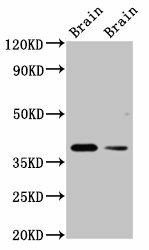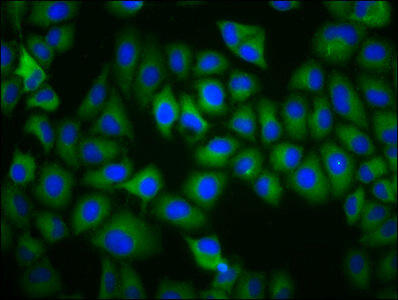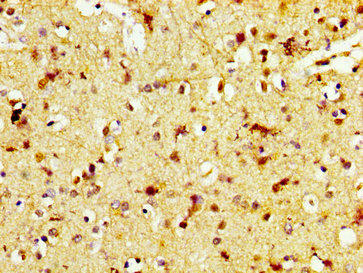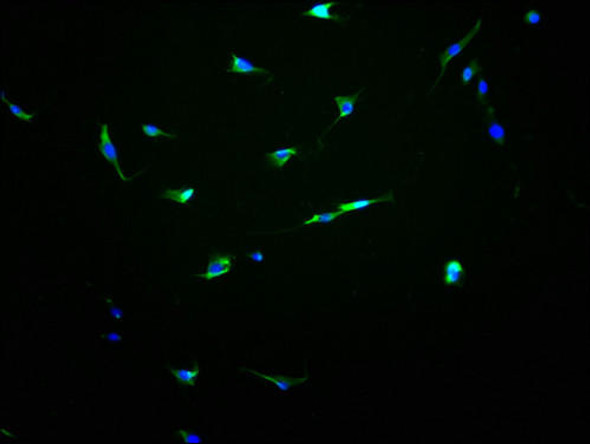Description
| Antibody Name: | TAAR5 Antibody (PACO55798) |
| Antibody SKU: | PACO55798 |
| Size: | 50ug |
| Host Species: | Rabbit |
| Tested Applications: | ELISA, WB, IHC, IF |
| Recommended Dilutions: | ELISA:1:2000-1:10000, WB:1:500-1:5000, IHC:1:500-1:1000, IF:1:200-1:500 |
| Species Reactivity: | Human, Rat, Mouse |
| Immunogen: | Recombinant Human Trace amine-associated receptor 5 protein (1-34AA) |
| Form: | Liquid |
| Storage Buffer: | Preservative: 0.03% Proclin 300 Constituents: 50% Glycerol, 0.01M PBS, pH 7.4 |
| Purification Method: | >95%, Protein G purified |
| Clonality: | Polyclonal |
| Isotype: | IgG |
| Conjugate: | Non-conjugated |
 | Western Blot. Positive WB detected in: Rat brain tissue, Mouse brain tissue. All lanes: TAAR5 antibody at 3µg/ml. Secondary. Goat polyclonal to rabbit IgG at 1/50000 dilution. Predicted band size: 39 kDa. Observed band size: 39 kDa. |
 | Immunofluorescence staining of Hela cells with PACO55798 at 1:200, counter-stained with DAPI. The cells were fixed in 4% formaldehyde, permeabilized using 0.2% Triton X-100 and blocked in 10% normal Goat Serum. The cells were then incubated with the antibody overnight at 4°C. The secondary antibody was Alexa Fluor 488-congugated AffiniPure Goat Anti-Rabbit IgG(H+L). |
 | IHC image of PACO55798 diluted at 1:600 and staining in paraffin-embedded human brain tissue performed on a Leica BondTM system. After dewaxing and hydration, antigen retrieval was mediated by high pressure in a citrate buffer (pH 6.0). Section was blocked with 10% normal goat serum 30min at RT. Then primary antibody (1% BSA) was incubated at 4°C overnight. The primary is detected by a biotinylated secondary antibody and visualized using an HRP conjugated SP system. |
| Background: | Olfactory receptor specific for trimethylamine, a trace amine. Also activated at lower level by dimethylethylamine. Trimethylamine is a bacterial metabolite found in some animal odors, and to humans it is a repulsive odor associated with bad breath and spoiled food. This receptor is probably mediated by the G(s)-class of G-proteins which activate adenylate cyclase. |
| Synonyms: | Trace amine-associated receptor 5 (TaR-5) (Trace amine receptor 5) (hTaar5) (Putative neurotransmitter receptor), TAAR5, PNR |
| UniProt Protein Function: | TAAR5: Orphan receptor. Ligands are likely small molecules, either sharing some similarities with trace amine as, e.g. derivatives of indolamines (such as 5-methoxytryptamine) or of phenylethylamines (such as phenylethanolamine) or being any kind of metabolite of amino acids or biogenic amine neurotransmitters. Belongs to the G-protein coupled receptor 1 family.Protein type: Receptor, GPCR; Membrane protein, multi-pass; Membrane protein, integral; GPCR, family 1Chromosomal Location of Human Ortholog: 6q23Cellular Component: integral to membrane; integral to plasma membraneMolecular Function: G-protein coupled receptor activityBiological Process: signal transduction |
| UniProt Protein Details: | |
| NCBI Summary: | |
| UniProt Code: | O14804 |
| NCBI GenInfo Identifier: | 82582283 |
| NCBI Gene ID: | 9038 |
| NCBI Accession: | O14804.2 |
| UniProt Secondary Accession: | O14804,Q2M1V1, Q4VBL1, Q5VUQ3, Q6NTA8, D8KZS1 |
| UniProt Related Accession: | O14804 |
| Molecular Weight: | 38,242 Da |
| NCBI Full Name: | Trace amine-associated receptor 5 |
| NCBI Synonym Full Names: | trace amine associated receptor 5 |
| NCBI Official Symbol: | TAAR5 |
| NCBI Official Synonym Symbols: | PNR |
| NCBI Protein Information: | trace amine-associated receptor 5 |
| UniProt Protein Name: | Trace amine-associated receptor 5 |
| UniProt Synonym Protein Names: | Putative neurotransmitter receptor |
| Protein Family: | Trace amine-associated receptor |
| UniProt Gene Name: | TAAR5 |
| UniProt Entry Name: | TAAR5_HUMAN |
| Antibodies |
| TAAR5 Antibody (PACO05669) |
| Secondary Antibody |
| Anti-HRP Goat Anti-Rabbit IgG (H+L) Antibody (CABS014) |
| Recommended Products |
| Anti-FITC Goat Anti-Rabbit IgG (H+L) Antibody (CABS011) |
| Anti-HRP-conjugated Beta Actin Antibody (CABC028) |






